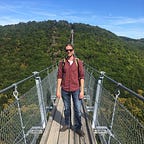Space Science in a Nutshell
Near-Earth Objects — Potentially hazardous?
Our cosmic vicinity is populated with thousands of minor bodies: asteroids, comets, meteoroids. Some of them approach our home planet quite closely: Near-Earth Objects, short: NEOs
It’s the 30th June 1908. A huge explosion devastated in a short period of time hundreds of square-kilometres in the Russian region of Tunguska. Millions of trees were bend and burnt down in this Siberian region. For the researchers and people who live there, this so-called Tunguska Event was a mystery of unknown cause.
What happened? Well, there are several explanations:
- A gas explosion. A large amount of methane or other gases ignited and caused this event.
- Another geophysical explanation: A volcanic-like eruption was mistaken for an explosion and devastated everything around the eruption centre
- An asteroid or comet entered the Earth’s atmosphere and exploded on its way to the surface. Similar as the Meteor of Chelyabinsk in the year 2013 that had a diameter of only 20 m
The last option is currently the most accepted theory. One assumes that the diameter of this asteroid was between 30 and 70 metres. It shows that even small celestial objects can have a catastrophic environmental impact on our home planet.
To remind us of cosmic hazards the Asteroid Day was introduced a few years ago. The date: 30th June — The day of the Tunguska Event.
Minor objects that revolve around the Sun close to our vicinity are called Near-Earth Objects (NEOs). The definition is purely based on the object’s dynamics. Thus, NEOs can either be an asteroid, meteoroid, comet or even human-made, like J002E3.
All objects that approach our Sun within a range of 1.3 AU are defined as NEOs. This definition is artificially set and does not correspond to any scientific insight or property. Additionally all objects with a size of at least 100 m and a minimum approach distance to our home planet with less than 0.05 AU are defined as potentially hazardous objects. A daily updated list of these objects can be seen at the bottom of spaceweather.com:
NEOs are separated into 5 dynamic groups: Amors, Apollos, Atens, Atiras and Vatiras. The definitions of these objects are listed below
As one can see, Apollos and Atens can cross the Earth’s orbit. This could clead to a collision with our planet (depending on the actual orbital elements, timing etc.). The fifth class, Vatira, is rather new and is a sub-class of the Atira class. Vatiras are NEOs whose orbit is within Venus’ orbit. Since these objects appear rather close to the Sun (as seen from Earth), they are difficult to discover and track. The first object was described in early 2020:
Currently, it is assumed that most “planet killers” have been discovered and catalogued. Objects with a diameter of a kilometre and more would have a devastating impact on Earth. However, smaller objects like Tunguska- or Chelyabinsk-sized NEOs are still being discovered every day. Spatial and size distributions are compared with recent simulations and models like the Granvik model from Granvik et al. (2018):
Their model suggests that hundred-thousands of smaller NEOs are still undiscovered… International shared efforts like Sky Surveys, follow up observations, simulations, risk computations and technological concepts to alter the orbit of NEOs help us to keep Earth and us as a species safe from cosmic hazards.
Thomas
Links and Resources
ESA’s Space Situational Awareness Program
JPL’s Center for Near Earth Object Studies
Recent NEO candidate updates (“confirmations”) on Minor Planet Center
A good source of orbital elements, statistics etc.: NEODyS
